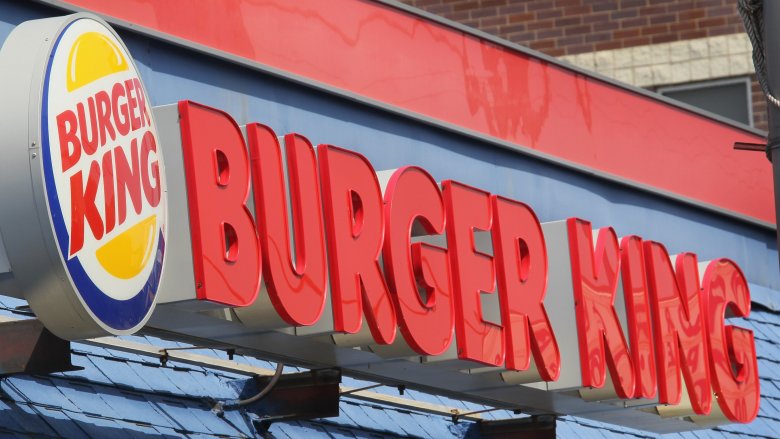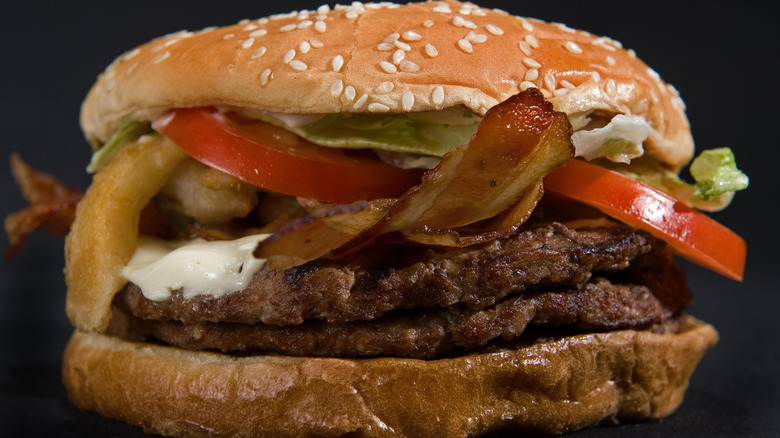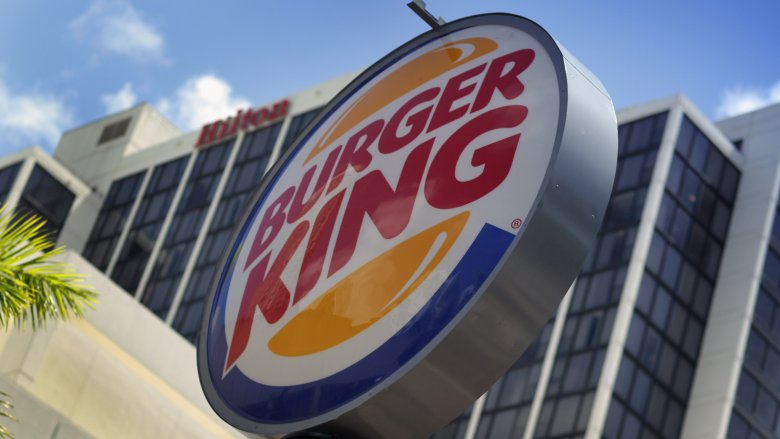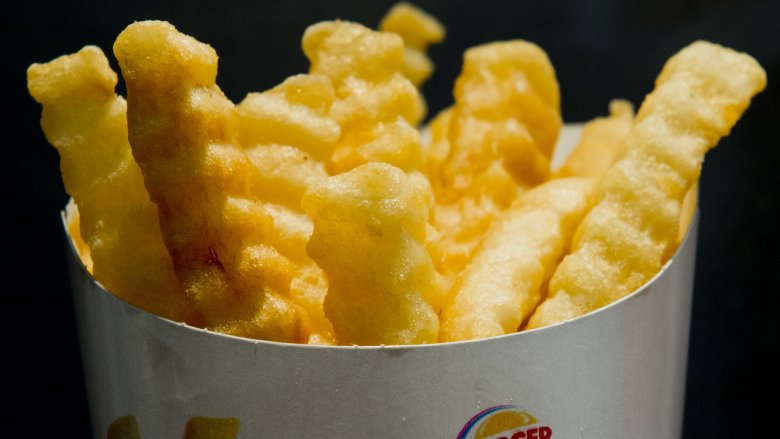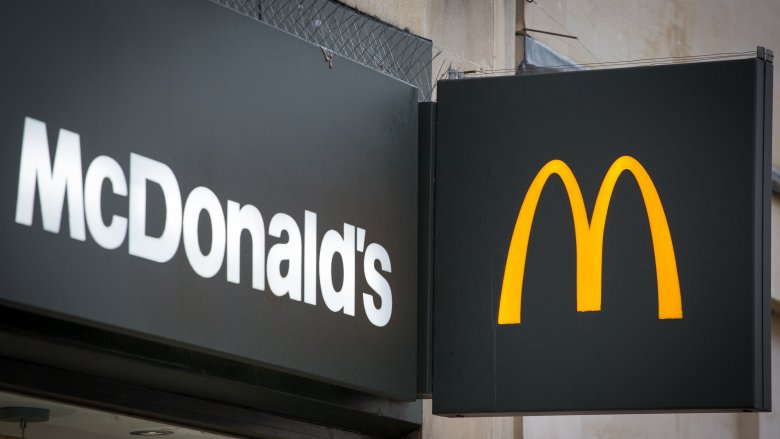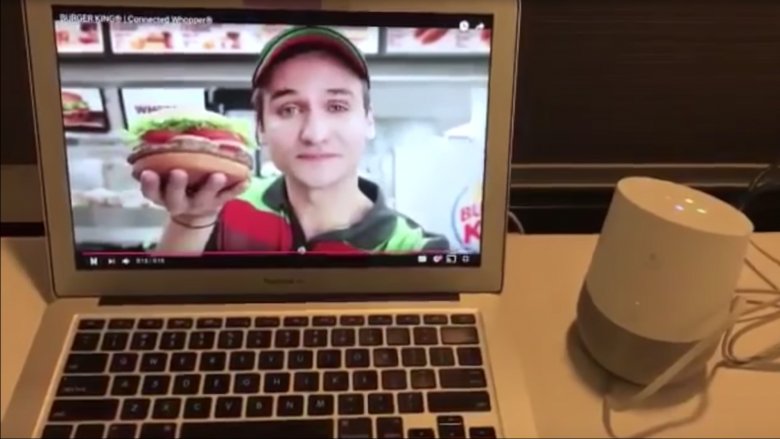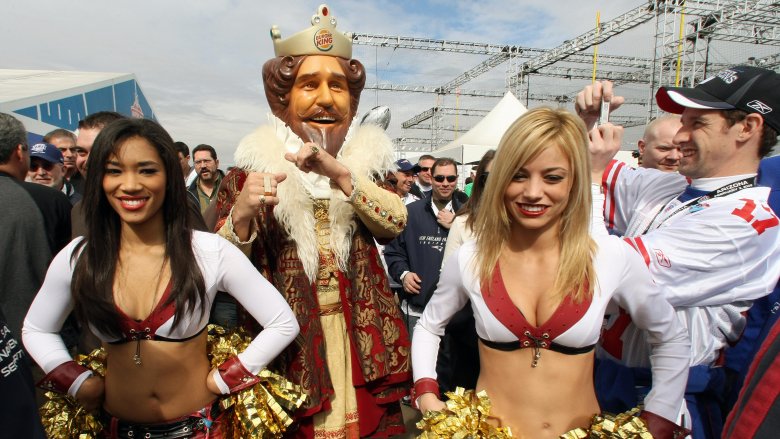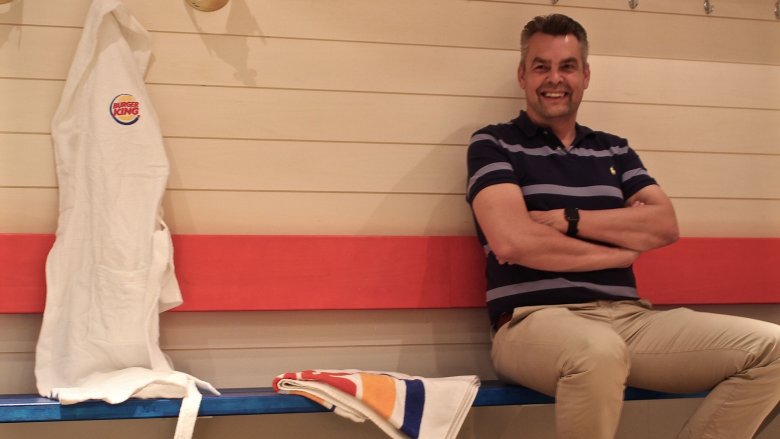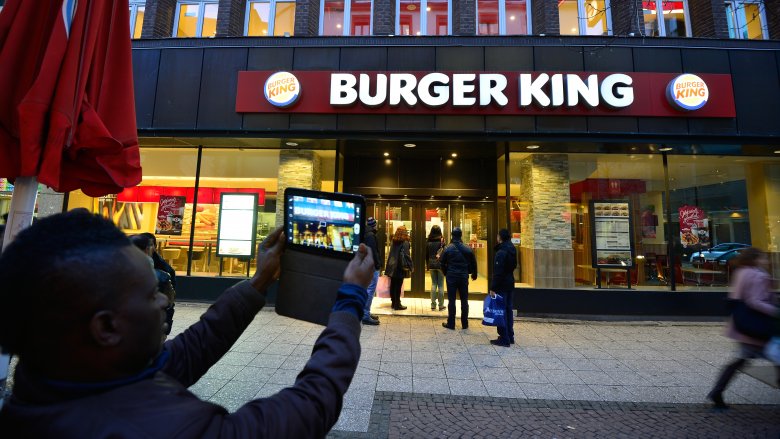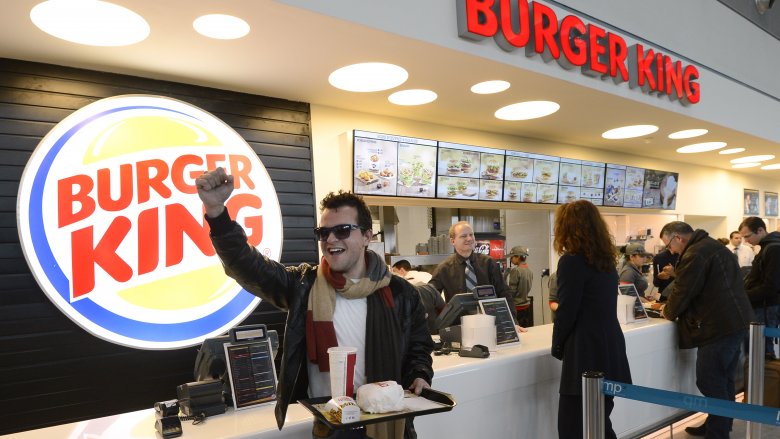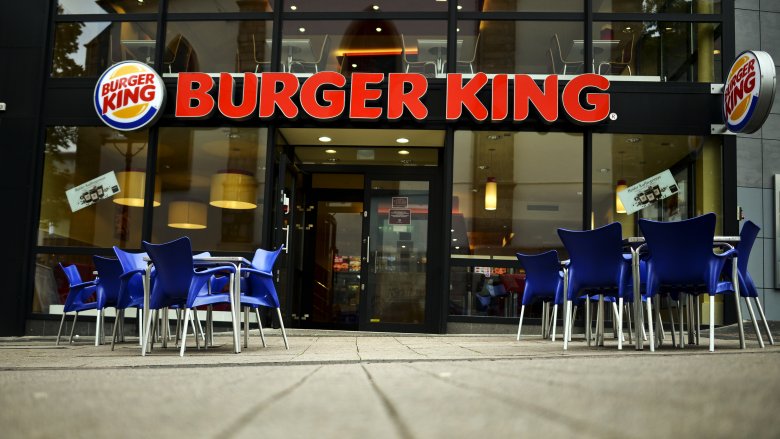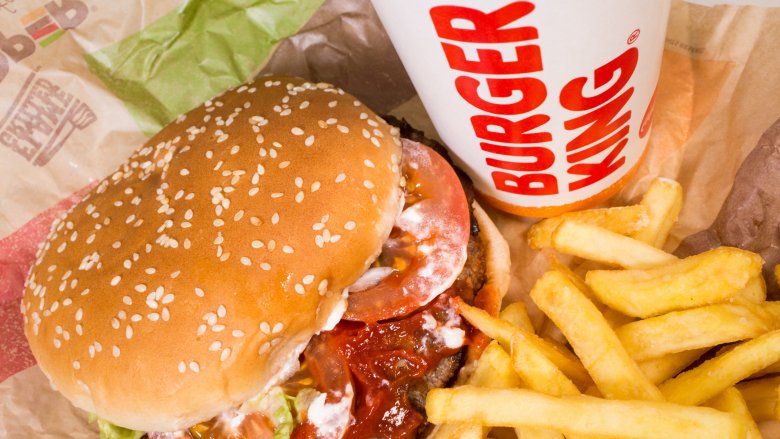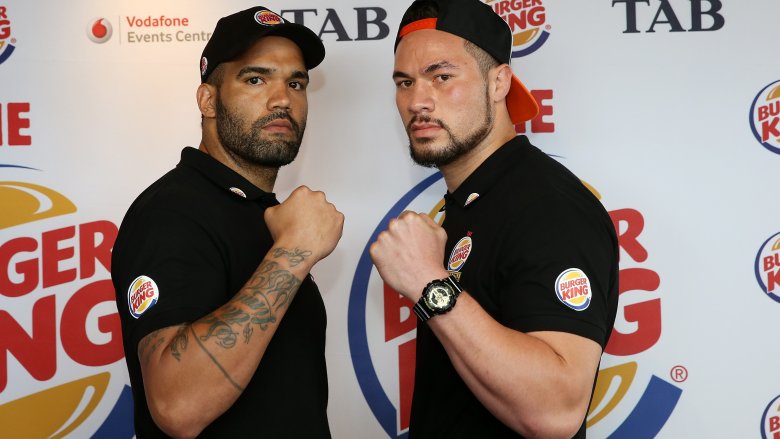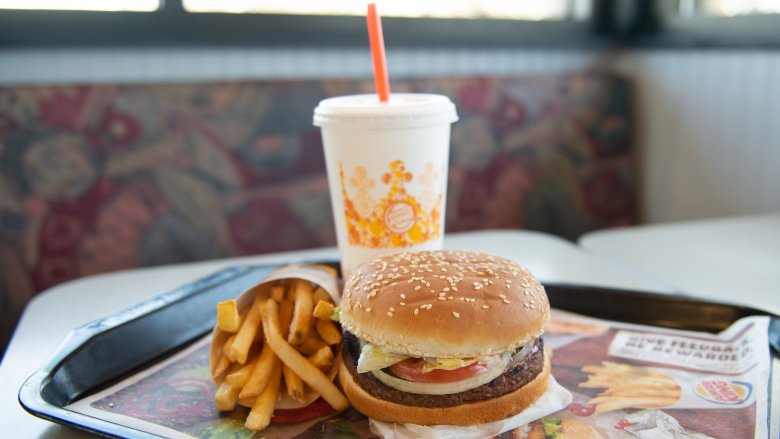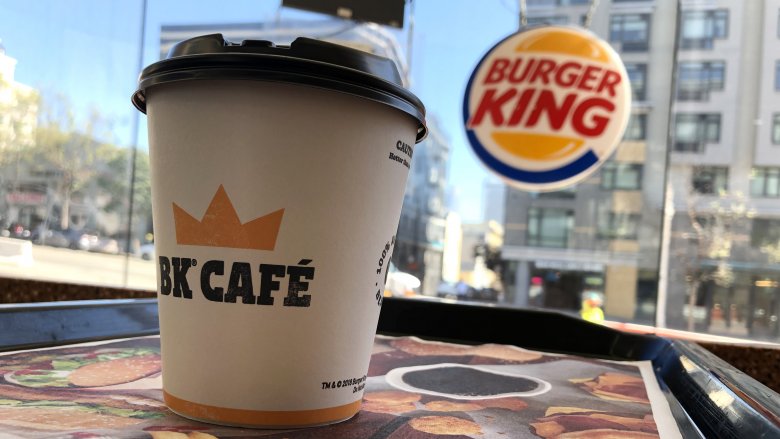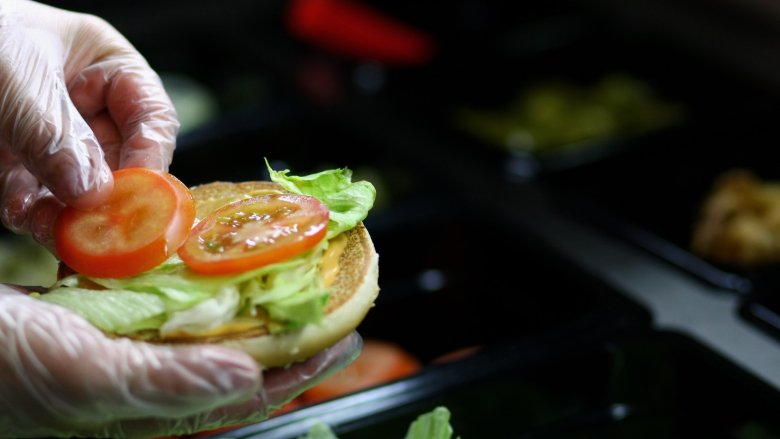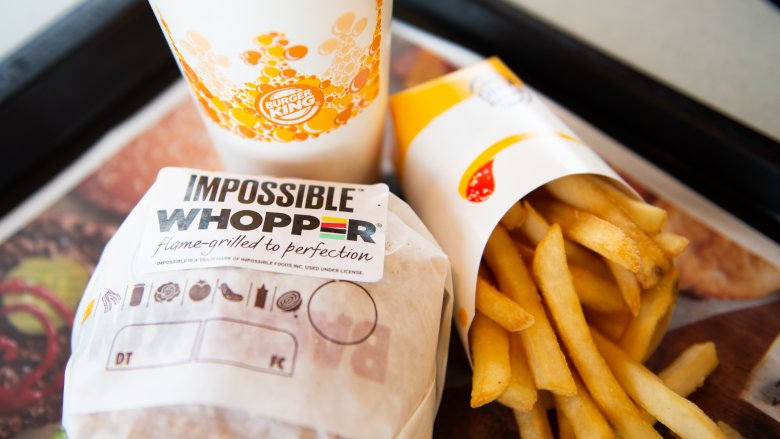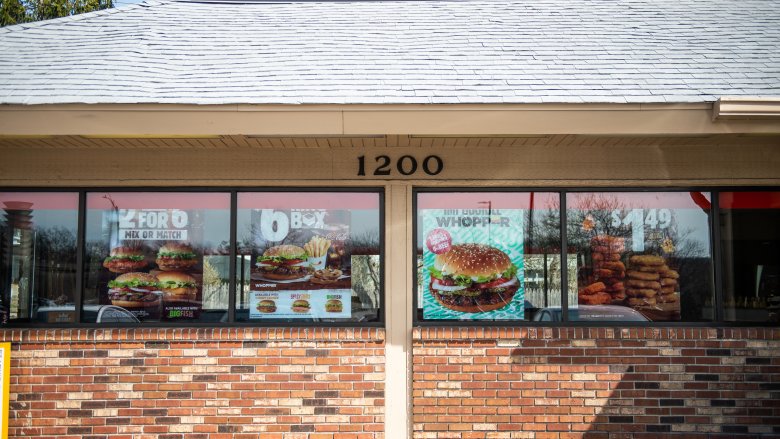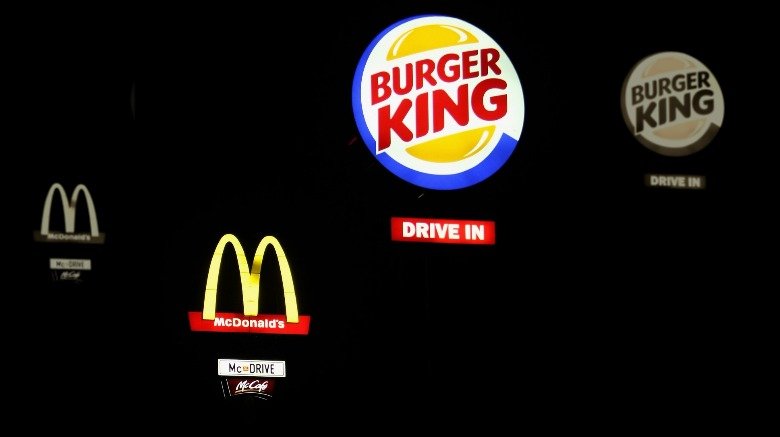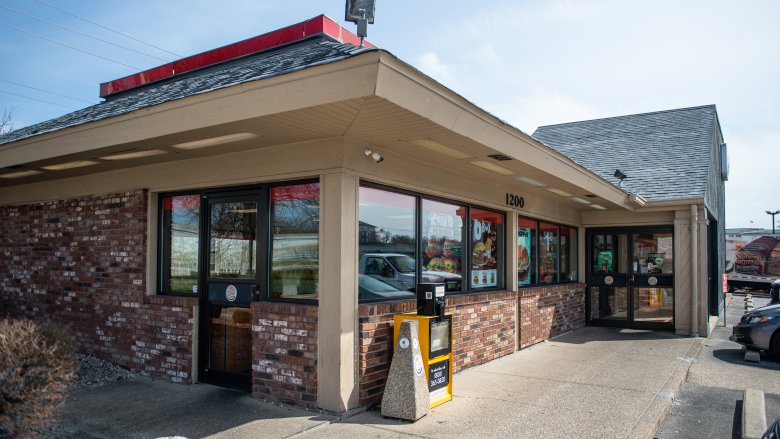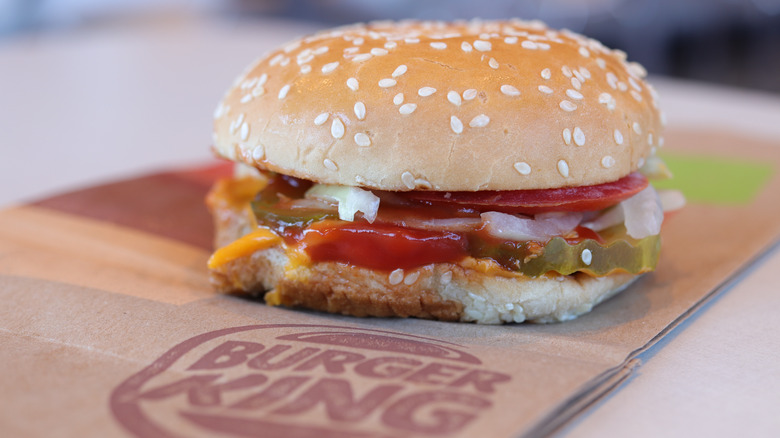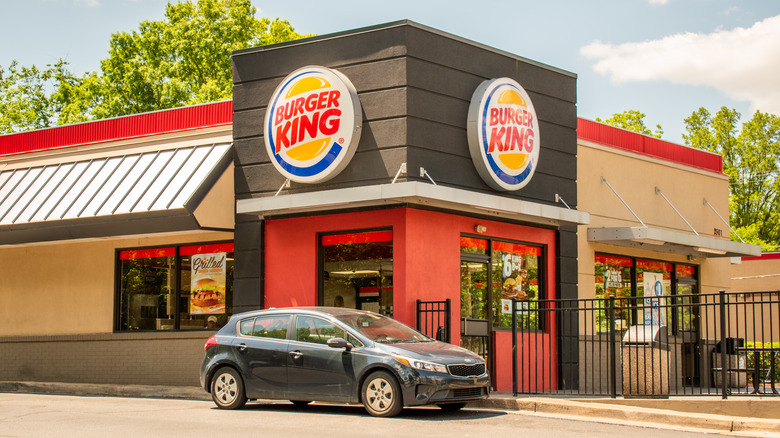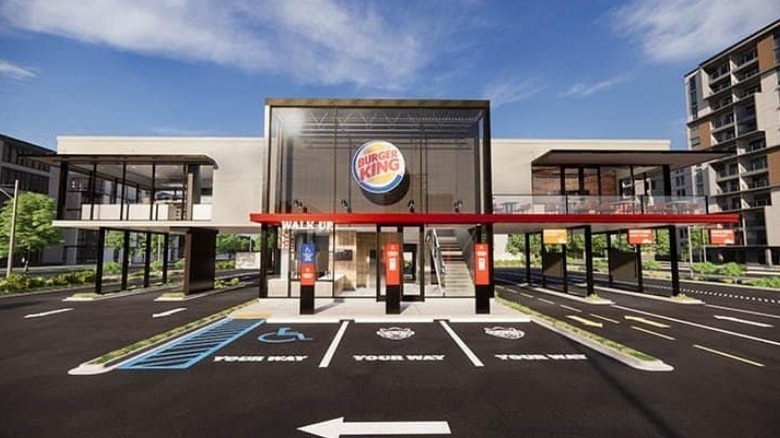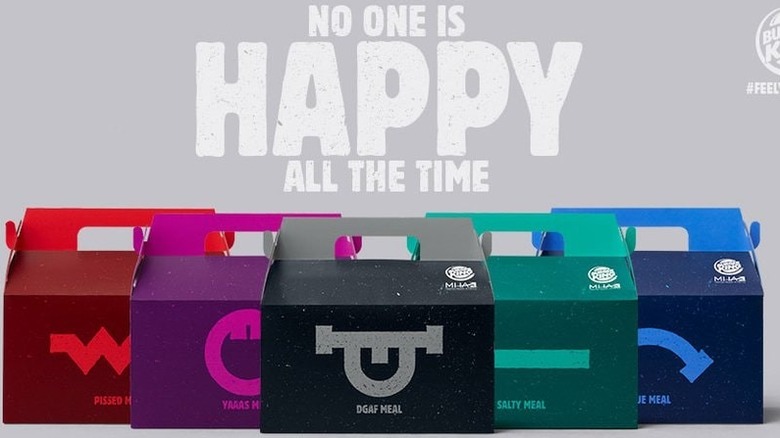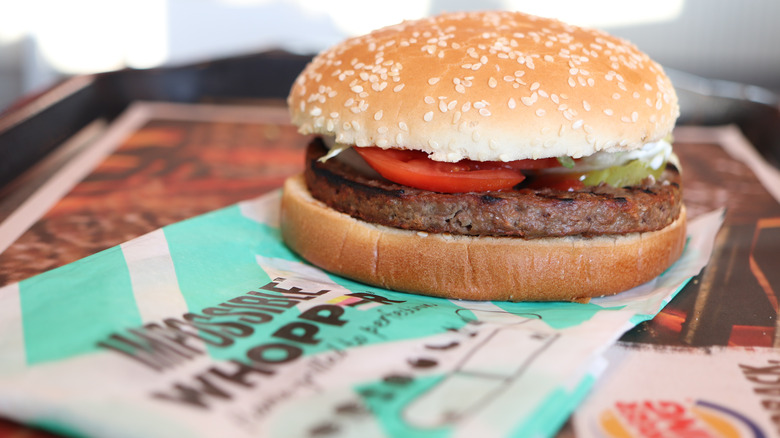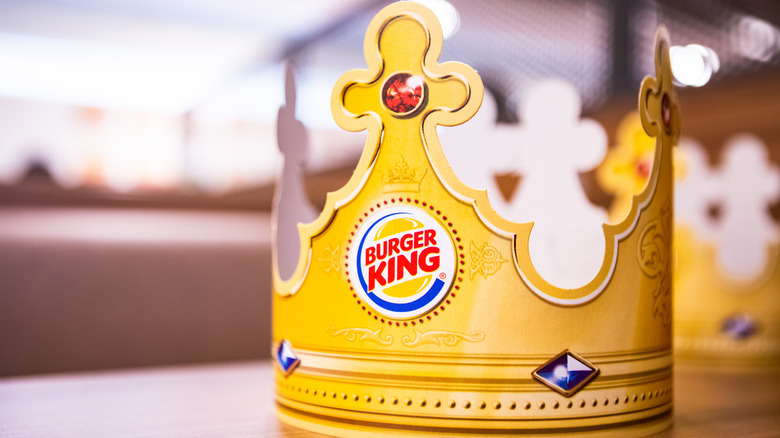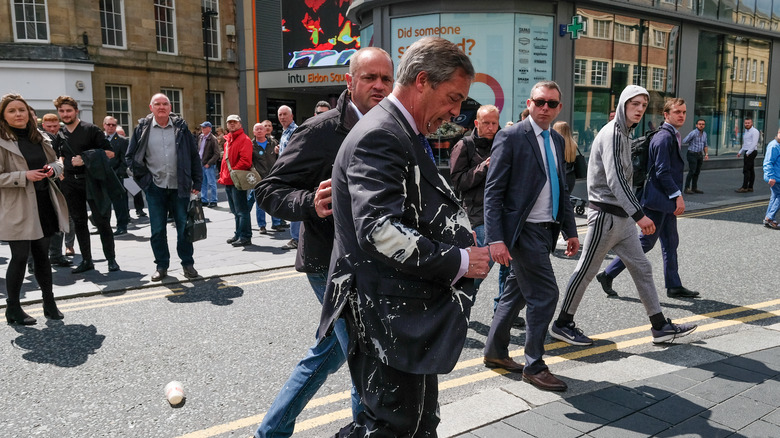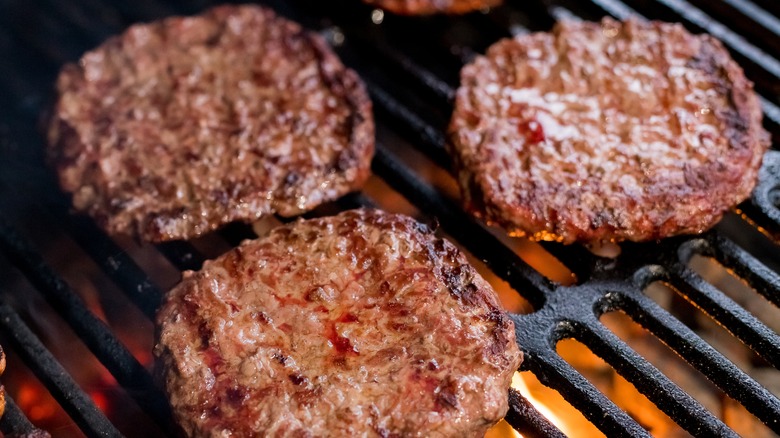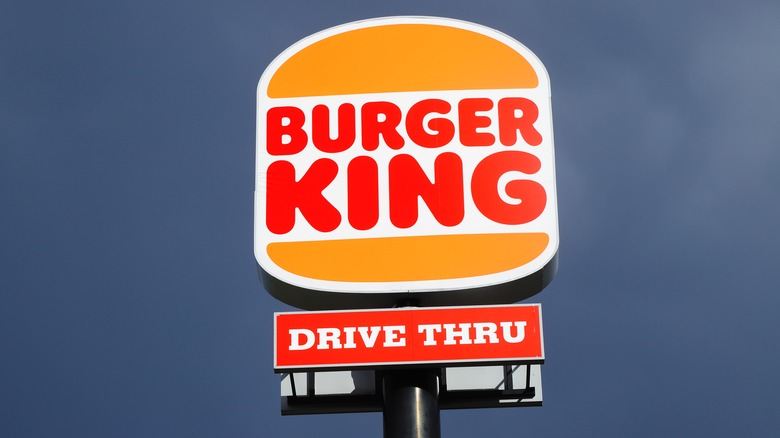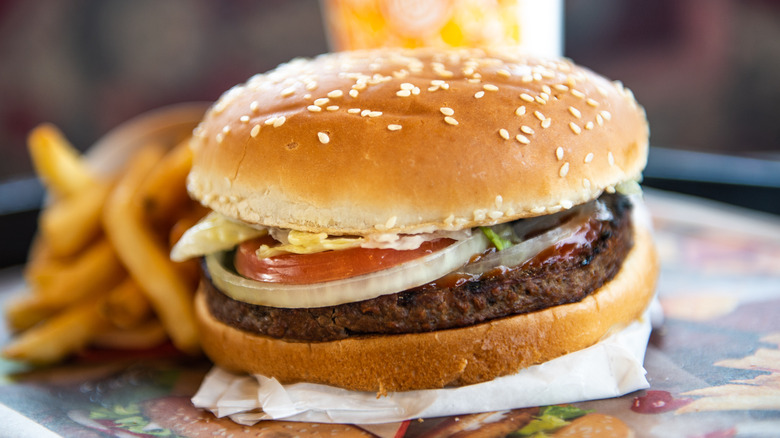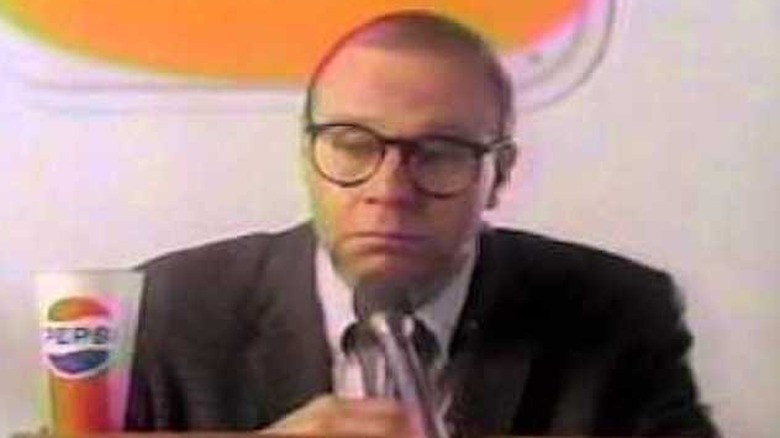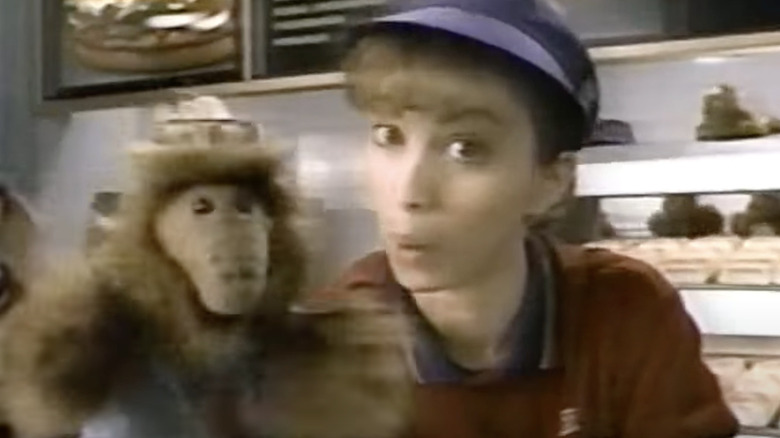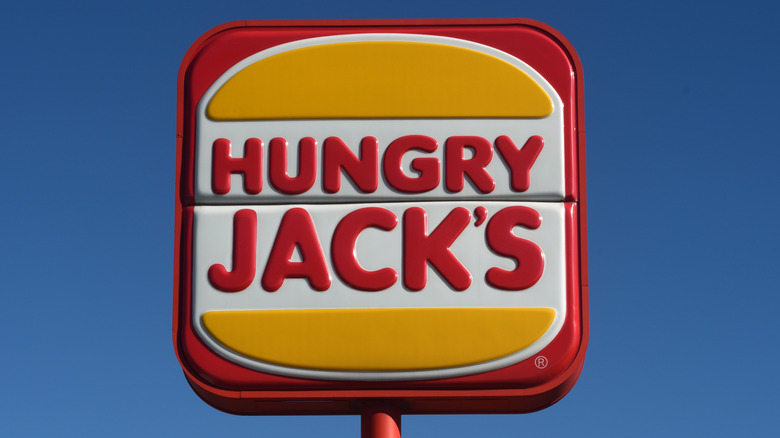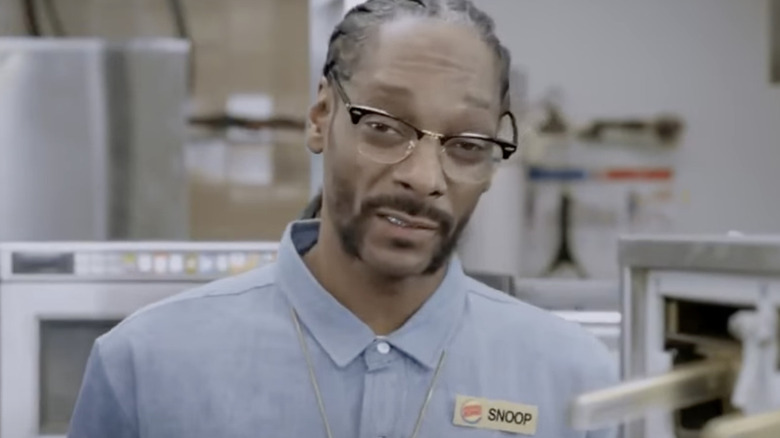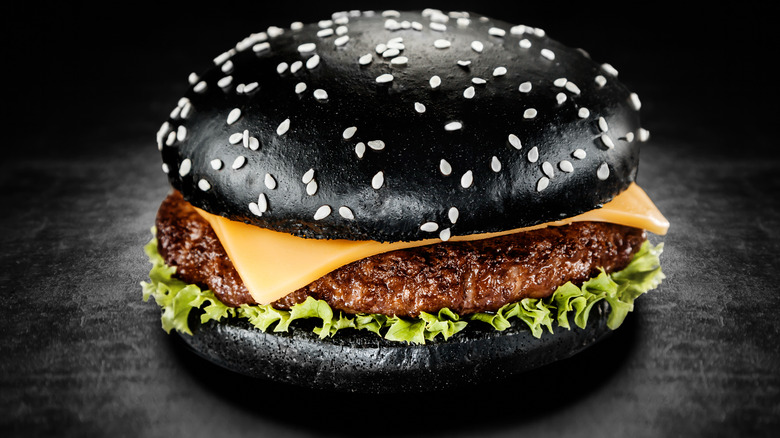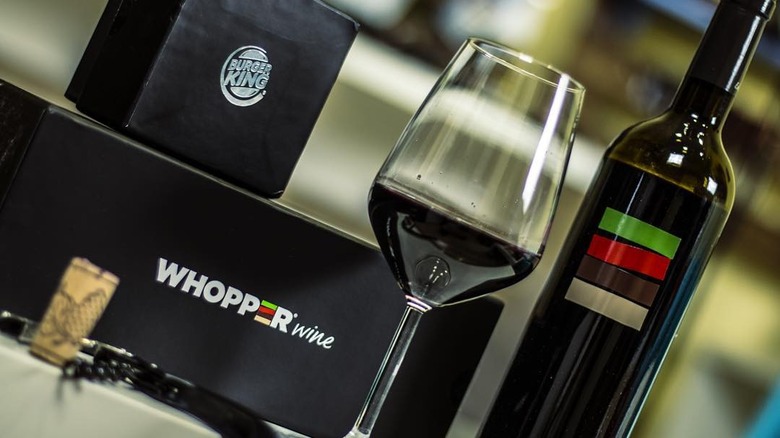The Untold Truth Of Burger King
It's tough to imagine a world without Burger King, a place where you can go to satisfy the craving for something meaty, salty, filling, and fast. Whopper or Big Mac is one of lunchtime's oldest debates, and even if you fall firmly on the side of the Whopper, there are still probably some things you don't know — or don't remember — about this American favorite.
Did you know, for instance, it wasn't always called Burger King? The chain started out in 1950s Florida, and it was called Insta-Burger King after one of their key pieces of equipment: a stove called the Insta-Broiler. When the Insta-Broiler went the way of the dodo and was replaced by the now-famous flame-broiler, the name didn't make much sense any more. It became just Burger King in 1961, and it wasn't long after that the so-called Burger Wars began. So, what else don't you know about this fast food giant?
The Whopper Sacrifice was brutal
It's not enough just to get the word out about your product, successful advertising means making people want to buy it. That's a tough thing to do in the ever-changing landscape of public opinion and social media, and in 2009 Burger King's ad agency Crispin Porter & Bogusky decided to use Facebook as a platform for some bizarre viral marketing. They created an app that awarded people a coupon for a free Whopper ... if they deleted 10 people from their friends list. No big deal, right?
What may have been all in good fun turned a little dark. The app also sent messages to anyone who found their friend status on the chopping block, letting them know their friendship was valued at less than one-tenth of a Whopper. Ouch.
Facebook shut the app down after only ten days, saying it was a massive violation of their users' privacy. In that time, CNET says the app was installed on almost 60,000 accounts, 20,000 of those people got free Whoppers, and 200,000 people had their feelings hurt. Suddenly, it's not so fun anymore.
Burger King vs. Burger King
Everyone knows what the BK logo looks like, and that makes the black-and-white signs of one Illinois Burger King look that much more out of place. There's a weird story here, and it starts with the Frigid Queen ice cream shop in Mattoon, Illinois. It changed hands in 1952, and when new owners thought they'd have a little fun with the name — "every queen needs a king", Atlas Obscura reports — they called their new burger joint Burger King. They trademarked the name in Illinois in 1959, and even though the other Burger King was already up and running, it hadn't made it to Illinois yet. When it did, there was a huge problem.
It's a classic case of David vs. Goliath, and in this case, the little guy won. Illinois courts ruled that Gene and Betty Hoots could not only keep their restaurant's name but they were also given a section of Illinois that was just theirs. The larger Burger King was forbidden from opening a location anywhere within a 20-mile radius of the Hoots' Burger King, and when they approached the Hoots to ask permission to set up shop within the radius, permission was denied.
Their healthy fries tanked
They were called Satisfries, and Time says that even when Burger King rolled out their lower-calorie, higher-price fries, it was with the caveat that sales would determine their ultimate fate. They started appearing on menus in September 2013, and by August 2014, many locations were getting rid of this healthier option.
Satisfries had about 40 percent less fat and 30 percent fewer calories than their standard fries (and cost more), but let's put this in perspective: the small serving still had 40 more calories than a small serving of standard McDonald's fries.
At the same time they were getting rid of Satisfries in most locations, BK also announced they were going to be bringing back another menu item: Chicken fries. Time Money says this little microcosm of fast food economics is the perfect demonstration of one of the biggest problems in the industry, and that's the healthy being pushed to the wayside in favor of the not-so-healthy — all done under the guise of giving people what they want.
They threw shade at little brother
In 2015, McDonald's turned 60. That's a big deal, but McDonald's is actually the younger burger-slinging sibling, and BK took the anniversary as an opportunity to remind them who had actually opened first — by a whole four months.
As part of McDonald's celebration, they introduced a "1955 Burger" and the tagline, "A Tribute to Where it All Began." It was a nice thought, and The Christian Science Monitor noted that BK's response was as epic as it was discreet. They trademarked "Since 1954" at the same time they trademarked "Be Your Way," and they started putting it everywhere.
That included global marketing campaigns, and in a way, it couldn't have come at a better time. Fox Business says that in 2018, the competition between Burger King and McDonald's hit an all-time high in the Asian market, so of course, the new trademark started appearing on their overseas press releases. Take that, little bro!
They created the longest 15-second ad in history
BK has a long history of some weird advertising gimmicks, and in 2017 they came up with the weirdest of them all. The idea was pretty epic, and it involved not just a commercial, but the hijacking of viewers' Google Home devices.
The American Marketing Association credits ad agency David with the idea, and it was basically to film a short commercial featuring an actor asking, "Ok, Google. What's the Whopper sandwich?" Any Google Home device that picked up the audio would answer by reading the Wikipedia entry for the Whopper, and that's a brilliant mind-meld of media, right?
Google definitely didn't think so, and they didn't appreciate having their users' devices exploited. The Verge says the ad was only effective for about three hours until the sound clip was added to the list of things Google Home wouldn't respond to. People had already taken the opportunity to edit the Whopper's wiki to include all kinds of questionable information, proving that even the most brilliant marketing strategies can be trolled, but still achieve the original goals. In this case, it was all about the "talkability", and it definitely got people talking.
Yes, everyone hates the mascot
The Burger King might be the most creeptastic food mascot out there, and if he gives you nightmares, you're not alone. Consumerist took a poll in 2014 to see what food mascots people found the creepiest, and he took almost 20 percent of the votes (also up there with the same percentages were the Quiznos Sponge Monkey and the old version of Ronald McDonald). Add in the fact that a huge number of the commercials featuring the Burger King were definitely nightmare-fuel, and you have a bizarrely uncomfortable mascot. (Waking up to find him in bed with you? Who thought that was a good idea?)
In 2011, Mother Jones reported we could all sleep a little better at night, knowing he was being officially retired in the midst of what BK said was an attempt to refocus their marketing strategy. The King didn't make the cut, but it was only four years later that Consumerist was announcing he was back on the front lines. Whether or not that's a good thing depends on how resistant your nightmares truly are.
You can visit a Burger King sauna
Burger King had a major first in 2016 when they opened the first fast-food sauna. Located in Helsinki, it's not entirely out of left field. Vice's Munchies says there are around 2 million saunas in Finland, catering to a population of around 5.5 million. But there's only one official one where you can go to relax, have an employee take your order, then chow down on a Whopper and some fries while sweating like crazy.
If you're so inclined, you can even rent it out for a private party. There's enough room in there for around 15 people — and their food — and they even sell robes embroidered with the BK logo. You can grab some beer from the fridge, kick back in front of the massive TV, and don't worry, you can also get a shower there afterward. It's surprisingly successful, and it's no wonder. Where else can you get the literal meat sweats?
They weighed in on net neutrality
Net neutrality is a huge issue, and a whole slew of celebrities and companies have entered the fray to weigh in on just how devastating it would be if internet providers were allowed to charge more for faster, priority service.
They translated the issue to their own business model to show just how ludicrous — and frustrating — it could be, with a commercial that asked customers if they wanted to pay more for their Whopper to get it faster (via Variety). Customers paid based on a Whopper's MBPS speed (which they called Making Burgers Per Second), and employees explained that since BK could make more selling chicken sandwiches, they were slowing down how fast customers could access the Whopper. Insane, right? Customers thought so, too.
If that didn't make it clear where Burger King stands on the idea of net neutrality, they even took it a step further. They directed viewers to a petition to help keep an open internet, and it's an admittedly brilliant way to make people aware of the potential dangers ahead.
The bling burger
In 2008, Burger King waded into the fray in the fight of the ridiculously overpriced burgers with a creation simply called "The Burger." Available in just one West London restaurant, The Burger was made with Wagyu beef, Pata Negra ham, Cristal onion straws, white truffles, and Modena balsamic vinegar, and anyone wanting to sample this high-end creation would first need to fork over £95, or around $200 (via Fox News). British papers weren't necessarily impressed — The Guardian condemned The Burger for its carbon footprint and its taste overload — but the stunt still gave BK the record for selling what was, at the time, the world's most expensive burger.
There was more to it than just a pricey lunch and an opportunity for some showing off to your friends, though. All the proceeds went to the Help A London Child charity, an organization that lends a helping hand to children and youth suffering through life circumstances like homelessness, poverty, illness, and abuse. At least that expensive lunch was for a good cause.
What's the deal with those Crown Cards?
In 2008, actor Hugh Laurie sent ripples of shock across the gossip network after making a single, off-hand comment to the London Times. He claimed one of the perks of being a celebrity was having a special lifetime, unlimited, BK Crown Card (via AdAge). He claimed other celebrities — like Jay Leno and George Lucas — also had the card, and it was an exclusive club to be in. Bloggers were equal parts shocked, envious, and hate-filled, and they all seemed to forget one big bit of information: before he was on House, he was a comedian.
Laurie didn't actually have one of the cards at the time, but got one after his comments caused an uproar. According to Cherie Koster, senior manager of the chain's Pay It Your Way program, Laurie makes the 12th celebrity to get one of the coveted cards. They're awarded for more than just celebrity: Jennifer Hudson got one after she skyrocketed to fame, because she's a former employee. You can get one, too — on their website — but you'll need to pay for yours.
You can order a Suicide Burger
Secret menus aren't really secret, they're more accurately described as menu items that aren't on the regular menu. BK has one of those items, and it's called the Suicide Burger.
Hack the Menu says it's an even bigger version of the Triple Stacker, and if your location doesn't know what the Suicide Burger is, you might be able to order it by another name: a Quad Stacker. There are four patties, four slices of cheese, a layer of bacon, and that special sauce that makes a BK burger, well, completely BK.
If that doesn't sound like it's on the healthy side, it's definitely not. There's no official nutritional information for it, but there is information out there on the Triple Stacker. That'll set you back 640 calories, 42 grams of fat, and 940 mg of sodium, and that's bad enough! Just imagine adding more of everything and the inevitable fries and a drink — as long as you're not planning on eating anything else for a few days, you'll still be sticking to your diet.
They're fans of the fisticuffs
There was a ton of hype surrounding 2015's "Fight of the Century," so when Floyd Mayweather, Jr. stepped into MGM there were a ton of people watching... and scratching their heads. With him were Justin Bieber and BK's Burger King mascot — which made us all a bit curious.
Vice's Fightland took a look at this unlikely partnership, and found it goes back a long way. George Foreman was such a fan of the fast food joint he had a training camp right next to a BK, and in 2008, the burger chain sponsored Jamaica's national boxing program to the tune of $500,000. They've supported boxing in New Zealand, too, had an advertising deal with Evander Holyfield, and filmed a commercial advertising their burgers and a hoax product designed to allow for hands-free eating. A boxer was featured in the commercial, and the creepy king even showed up in EA Sports as an unlockable boxer.
They definitely love their boxing, and in 2018 UFC's Conor McGregor teamed up with them — and the Burger King — for a weirdly disturbing advertisement (via Vice). Clearly, they're all about fisticuffs of any kind.
They helped Impossible Foods run out of Impossible Burgers
You wouldn't expect Burger King to be on the cutting edge of changing the way we eat lunch and even the way we think about food, but they totally are. In early 2019, they announced (via Vox) that they were going to be giving the Impossible Burger — the 21st century's most promising meat-free burger — a trial run in 59 of their St. Louis-area stores. It didn't take long — less than a month — for them to see it was a massive success, and they announced (via Vox) that they were going to have Impossible Whoppers in every store across the country by the end of the year.
That's a huge deal. Sure, they're following in the footsteps of White Castle and Carl's Jr., but Burger King? It's everywhere, and if there's anyone that can take meat-free burgers mainstream, it's them.
And according to CNN, it didn't take long. The same week Burger King announced they were going to be selling Impossible Whoppers everywhere, Impossible Foods said they were scrambling to supply the overwhelming demand for their burgers. Pre-BK, they were supplying around 7,000 locations, and with the addition of all BK restaurants, that added another 7,300 onto their distribution, and they needed to do a lot of work by the end of the year to make that happen. The Impossible Whopper, the burger of the future?
Their weird publicity stunt to pay off student debt
Burger King is a weird place: Just look at their mascot, then tell us that king doesn't rule over a slightly dystopian future where his image is broadcast on giant television screens to all the workers, "1984"-style.
That got dark. But that's the feel they gave out when they tweeted something strange on May 22, 2019: "got student loans? what's ur $cashtag?" What followed was a feeding frenzy of people wondering whether or not BK was serious, if they were really handing out money, and if people were going to have to fight for it.
The next day, they answered: "for real tho, we're trying to pay off those loans. introducing Whopper Loans — make a purchase through the BK app for a chance to have your student loans paid off."
That's... good? Bizarre? Both? You decide, but GQ came down firmly on the side of weird. They were skeptical that BK was doing it for any reason save to sell more burgers (and maybe push people toward buying things through their app), but there's no question it came at a time when the student loan problem was a huge one: College graduates were carrying around $1.5 trillion in debt.
You can get a Whopper delivered if you're stuck in traffic
Ever been sitting in traffic and thought, "Man, I wish I had a Whopper right now." Yes? Perfect, because Burger King has heard you and they're working on it. In 2019, BK announced that the rollout of The Traffic Jam Whopper campaign was a massive success. They had tried it in Mexico City first, and here's how it works:
Say you're sitting in a bumper-to-bumper traffic jam, and you enter an area that's in a 1.9-mile radius of a Burger King. You can pull out the app, order a Whopper meal, and someone on a motorcycle will momentarily be at your car window with your order. The app also tells you everything you need to know, using real-time data to figure out things like how long you have to place an order before you'll be out of delivery range. According to Nation's Restaurant News, it increased their deliveries by 63 percent.
And yes, this technology is going to be coming to the most congested cities near you. Los Angeles is first on the list. Is it genius, or completely unnecessary? You decide.
They love April Fools' Day
When Burger King announced they were going to be selling those Impossible Whoppers, they did it on April Fools' Day in 2019. Everyone "caught on," thinking it was a hilarious joke, and it was — but not because it was a joke. Because it was true.
It took outlets like Fortune reporting that it was actually true to get people to believe it, and it's easy to see why it was a stretch. Burger King loves a good April Fools' Day prank, and they always have. Take 1998 — that's the year they announced they were going to be making a Left-Handed Whopper, specially designed to be held in the left hand with ingredients balanced to keep from spilling out the side. It was billed as the "ultimate HAVE IT YOUR WAY" for all the long-neglected, left-handed customers, and think no one could possibly fall for that? The Museum of Hoaxes says that on April 1, BK had thousands of customers request the new Whopper.
They've also done a Chocolate Whopper and Whopper-flavored toothpaste, but the best might be yet to come. In 2019, they put out a call for students of all ages to tell them what prank they should play next, and the winner would see it all come to life (via The Drum).
BK is the reason we have Ellen DeGeneres
Ellen DeGeneres has been around for a long time, and strangely, you can thank Burger King for helping her get her big break. When she talked to Oprah's Master Class (via HuffPost), she told the story of how she got her start. She was living in New Orleans and working all kinds of odd jobs while she explored the possibility that her friends were right and she would make a brilliant comedian. When they all attended a fundraiser, those friends pushed her to get on stage and "do something funny". She didn't have any jokes, though: She had a Whopper, fries, and a shake, and explained to the crowd that she hadn't eaten all day, and hoped no one minded.
She continued: "Then I would say, 'But what I wanted to talk about was...' and then I would take a bite. While I was chewing, I'd put a finger up and then just go, 'Oh, that is good. That's better.' Then I would start the sentence again. I ate the entire meal and didn't finish the sentence."
She switched up the routine after that for some more unexpected bits, but she called them something else. "That's what I did for the first few times on stage. I just did stupid things." Stupid, or brilliant?
They tried to make the McWhopper happen
It's the age-old question: Burger King or McDonald's? If Burger King had any say about it, there was going to be a product that would have let you enjoy the best of both worlds... but McDonald's shot the idea down with an almost brutal response.
In 2015, Burger King extended the flag of peace and took out a full-page ad in The New York Times. They wanted a ceasefire to the burger wars, and they proposed something pretty epic: the McWhopper. There was a catch, though. The burger, they said, would be available for one day only: Peace Day, or September 21, 2015. The idea was to promote Peace Day and education, and that's a pretty lofty goal.
But McDonald's wasn't having any of that. According to Reader's Digest, the ad was the first McDonald's ever heard of it, and the CEO of McD's took to Facebook to decline the offer in a post that included the sentiment that "between us, there is simply a friendly business competition and certainly not the unequaled circumstances of the real pain and suffering of war," then ended with, "A simple phone call will do next time."
So much for peace.
The cost of starting a franchise is shocking
Owning your own BK franchise would be cool, right? Just think: It's essentially unlimited fries, and you can't beat that.
When it comes to their business model, there's something a little different about them. According to The Motley Fool, they're unusual in that almost all of their locations are owned and operated by franchisees instead of corporate. That happened in 2010, when corporate-owned locations dropped from 1,000 down to only 52. That's strange, because when corporate owns and runs a number of locations in a range of places, it makes it easier for them to get a grasp on trends and customer demands. Still, they more than tripled their cash balance between 2010 and 2014, so it must work.
And some of that might be because it's no small feat to buy into a Burger King. Not only do they require franchisees to pay a $50,000 upfront fee to the company, but they then have to shoulder all of the start-up costs. Depending on the situation, that could be well above $500,000. And that's probably why they require all new franchisees to have that $500,000 available to them in liquid assets and a complete worth of at least $1.5 million.
On second thought, it's easier just to order some fries through the app.
The Whopper is now free of artificial preservatives
It's no secret that consumers are looking for healthier meal options, even at fast food restaurants, and Burger King is responding. In September 2020, TODAY reported that the company announced its iconic Whopper burger was now free of artificial ingredients, colors, and preservatives. "We put a lot of effort into the Whopper to make it taste great and the real Whopper free of colors, flavors and preservatives from artificial sources has the same iconic flame-grilled flavor that guests know and love," Chris Finazzo, president of Americas at Burger King, said. "This announcement further highlights our commitment to serve delicious, affordable meals our guests can feel good about."
Burger King used a number of marketing tactics to get the word out about their new and improved product. For a brief time, the chain served the Whopper in a redesigned wrapper that included a list of all the burger's new and improved ingredients. More memorable, however, was Burger King's "moldy" ad campaign, which showed a Whopper getting overtaken by mold over time, thus proving the absence of any preservatives (via Designboom).
"We knew that the approach was different and that some people would think that it's too risky or would hurt us," Burger King's global chief marketing officer Fernando Machado told Business Insider. "But people are smarter than that, and the biggest risk for us is to go with an idea that would fall flat."
Burger King is closing stores
If chain restaurants weren't struggling before COVID-19 (though many already were), the pandemic pushed quite a few over the edge. As a result, even the largest fast food names have been forced to close stores. Burger King is no different. In August 2020, Restaurant Business reported that Burger King's parent company, Restaurant Brands International,would be closing several hundred underperforming locations of its three brands, which also include Tim Hortons and Popeyes. It was a drastic turn for the company, which had opened more than 1,000 Burger King restaurants just a year before.
The one hitch in the plan, however, is that Burger King cannot act unilaterally as a single company. Nearly all Burger King locations are franchises, meaning the company has to convince the franchisees to shut their doors. But that's something executives don't believe will be a problem. "[Burger King has] worked closely with our partners to identify underperforming unprofitable restaurants that it makes sense to close," Restaurant Brands International CEO Jose Cil said (via Restaurant Business). "We believe this process of replacing older parts of our network with new modern restaurants and strong locations, drive substantial benefits and returns for both our partners and for us over the long term."
Burger King fans shouldn't be too alarmed by the changes, though, at least not for a long time. The restaurant still has more than 7,000 U.S. locations, making it the sixth-largest chain in the country.
New Burger King restaurants will look different
The fast food retail model hasn't changed much in the past half-century or so. Essentially, you either dine inside or go to the drive-thru. But if the COVID-19 pandemic has taught us anything, it's that the way we interact with retail businesses is changing fast. Quick-serve restaurants, including Burger King, are trying to keep up by rethinking the way they serve their customers. Late last year, per CNN, the chain unveiled two new restaurant designs of the future, aimed to meet the changing times.
"We're seeing more and more guests wanting to dine off-premise, wanting to use drive-thrus, wanting to do takeaway," said Josh Kobza, chief operating officer for Burger King parent company Restaurant Brands International (via CNN). "With Covid this year, many of those shifts in consumer preferences have accelerated."
Recognizing that fewer and fewer people are eating on-premises, the new designs include features such as triple drive-thrus, with one lane dedicated exclusively to delivery drivers. They also have pickup lockers and takeout counters, allowing customers to order and receive their food without ever stepping inside. One of the designs doesn't have any indoor dining space at all. According to CNN, Burger King plans to build new prototype restaurants in Miami, Latin America, and the Caribbean in 2021, while incorporating some of the new design features into existing stores over time.
Burger King's Real Meals received major backlash
Mental health has been pushed to the forefront in recent years, a movement Burger King attempted to publicly support back in 2019, but with very mixed results. In May of that year (also Mental Health Awareness Month) the chain unveiled a lineup of limited-time "Real Meals" designed to acknowledge a person's varying moods (via CNBC). Accordingly, the products were given such names as the Blue Meal, Salty Meal, Yaaas Meal, and the DGAF Meal. "Burger King restaurants understands that no one is happy all the time," a company statement read. "That's why they're asking guests to order a Whopper meal based on however they might be feeling."
While some appreciated the effort to raise mental awareness, others thought the chain was making light of a serious issue. "Mental disorders are not just moods like 'pissed' and 'DGAF,'" one person wrote on Twitter (via CNBC). "They cause terrible suffering and hundreds of suicides every day. This new campaign of yours is extremely distasteful."
Others took aim at the chain cashing in on a very serious problem. "My mental wellness is not a marketing tool. It's not something food, or massages, or theme months or pithy quotes about loving yourself will fix," another Twitter user wrote. Another noted that unhealthy food, such as the Real Meal featuring a Whopper and French fries, isn't great for your mental health in the long term, either.
Burger King's Impossible Whopper isn't vegan
Burger King made waves in the fast food industry in 2019 when it unveiled its Impossible Whopper, made from a meatless patty courtesy of Impossible Foods (via TODAY). The chain hoped its new version of an iconic menu item would be a success amidst the growing meatless burger trend — and it was right. According to CNN, the Impossible Whopper helped sales to grow 5% in one quarter, leading a company spokeswoman to call it, "one of the most successful product launches in brand history" (via New York Post).
Ironically, however, the two groups of people not impressed with the burger have been vegans and vegetarians, who note that the product isn't strictly meat-free. According to Restaurant Dive, the Impossible Burger is prepared on the same grill as meat patties. Furthermore, the sandwich contains egg-based mayonnaise, so it's definitely not vegan. Although it might seem like semantics to some, Reuters notes that the issue was serious enough to several customers that they filed a class-action lawsuit, claiming Burger King misled customers into thinking the Impossible Burger was vegan. The suit was eventually thrown out.
For its part, Burger King now includes a note on its menu reminding customers that "a non-broiler method of preparation" is available for those looking for a truly meat-free burger. Plus, you can always ask to skip the mayo.
Burger King has a new loyalty program
In the dog-eat-dog world of fast food, restaurants need to do all they can to get customers in their drive-thru instead of those of their competitors. One such method growing in popularity is rewarding frequent diners with discounts, free food, and other goodies. With that in mind, Burger King rolled out its new loyalty program, known as "Royal Perks" per Nation's Restaurant News, in fall 2021, just months after its rival McDonald's did the same.
"Customers are looking forward to getting items and menus that are personal to them and more useful to them," Burger King's chief marketing officer Ellie Doty told Nation's Restaurant News. "They expect to be rewarded today for their loyalty to the brand and frequency of use. I think that is true more so today than even two years ago because customers are looking for brands to understand what their past behaviors were to make their experiences moving forward even better."
The program rewards customers with 10 "crowns" for every dollar spent at the restaurant. Burger King patrons can then redeem those crowns for certain menu items. Royal Perks members are also allowed to upsize certain items for free with each purchase. The chain plans to make the loyalty program, which was beta-tested in several markets beginning in February 2021, available in two-thirds of its locations by the end of September.
Burger King has had a few major social media gaffes
Fast food restaurants have a pretty complicated history when it comes to Twitter. They've used the platform to gain glory for roasting their critics and make headlines for some of the Internet's most entertaining social media feuds like the notorious fast food chicken wars. But for all the good Twitter has done, it's also proved to be a minefield, something Burger King has experienced several times in recent years.
In October 2019, Sky News reported that a Whopper outlet tweeted this message: "Dear people of Scotland. We're selling milkshakes all weekend. Have fun. Love BK. #justsaying" Sounds innocent, but context is everything. This tweet came a day after two politicians had milkshakes thrown at them while campaigning. Some, therefore, believed the tweet encouraged violence, a claim Burger King was quick to shut down. "Our tweet regarding the situation in Edinburgh was intended to be a tongue-in-cheek reaction to the situation," the company said. "We'd never endorse violence — or wasting our delicious milkshakes! So enjoy the weekend and please drink responsibly people."
Earlier this year, Burger King found itself in trouble again when, on International Women's Day, the chain's UK division tweeted the message, "Women belong in the kitchen" (via Restaurant Business). The words were actually meant to highlight the lack of female head chefs and to promote a new scholarship for the chain's female employees. Most people instead found it sexist and little more than provocative clickbait.
Unlike some competitors, Burger King's burgers are flame-grilled
Every company has to have an angle — a hook that makes the brand and its products stand out amidst a high volume of competitors. For Burger King, a big player in the quick-serve hamburger industry, that special and defining characteristic is its flame-broiled burgers. That's a fancy and memorable way of saying that Burger King locations cook their hamburger patties over an open, controlled fire broiler, imparting a similar taste as one would get from a backyard cookout setup. That's a different process than the one employed by many competitors, particularly industry leader McDonald's, which uses a double-sided, quick-acting grilling apparatus, without any fire.
"Flame broiled" has been part of the Burger King lexicon, figuring prominently in the chain's marketing materials, for decades. However, for a brief period in 2003, Burger King attempted to reverse falling sales figures by trying to put a healthier spin on things. according to the New York Times. As part of that effort, Burger King proclaimed for a while that its burgers weren't "flame broiled" but rather "fire grilled."
Burger King rebranded in 2021
Big changes came to Burger King in early 2021. It wasn't anything on the menu, but rather the company's branding – an umbrella term for its logos, signage, color palette, and overall visual scheme used in restaurant interiors, advertising, and marketing materials. At the point of the rebranding, according to Insider, the fast food company hadn't changed its look in more than 20 years, adopting a slick, slanted, and shiny new logo in 1999. That marketing centerpiece was "modern and a bit shaper around the edges," said designer Debbie Millman of the logo she helped create. "Swooshes and gradients were all the rage back then." While it took Burger King a long time to get rid of that logo, it simply had to be cast out, according to design experts like Steven Heller. "Blue isn't a color that food companies use as a rule," he said about one aspect of the 1999 logo.
The new look, which bears a resemblance to mid-20th century Burger King visuals, is essentially the word "Burger" printed smaller than "King," upon which it sits, with both words sandwiched inside of two halves of a hamburger bun. That retro look reflects a change in company philosophy. "The redesigned logo reflects a new era for Burger King and its commitment to fresher, cleaner ingredients is best represented by looking back to simpler, less processed times," Millman explained to Insider.
Burger King likes to offer Whopper deals
According to "The Hamburger: A History," Burger King cofounder Jim McLamore was instrumental in the development of what became the modern, recognizable incarnation of Burger King, turning it around from a failing chain called Insta-Burger King by introducing big, broiled hamburgers in the late 1950s — cashing in on a backyard cookout trend that captured America's' attention. Then around 1957, noticing that some restaurants were starting to serve burgers so large that they were a novelty, McLamore pushed to add one to Burger King's menu. "I suggested that we call our product a Whopper, knowing that this would convey imagery of something BIG," McLamore wrote in his autobiography, "The Burger King" (via The Washington Post).
The Whopper would change the face of fast food — eventually. Left alone as the only extra-big burger among major fast food brands for more than a decade (McDonald's introduced the Big Mac in 1968 and the Quarter Pounder in 1972), giant meat sandwiches are now a matter of course at every burger franchise in North America. In 2012, to differentiate the Whopper from a crowded marketplace and to remind customers of its first-in-the-field status, Burger King celebrated the 55th anniversary of the signature burger by temporarily charging just 55 cents for the iconic sandwich, per The Washington Post. Nine years later, to commemorate 64 years of the Whopper, Burger King dropped the price even more, serving up Whoppers for a mere 37 cents (via USA Today).
Sarah Michelle Gellar's Burger King commercial led to controversy
In the early 1980's, Burger King threw down the proverbial gauntlet against its biggest competitor in commercials starring a young Sarah Michelle Gellar. The ads directly criticized McDonald's, with one alleging that the mega-chain's burgers were 20% smaller than the ones offered at BK. At the end of the ad, Gellar claims that she exclusively eats at Burger King to show McDonald's just how she feels about this.
McDonald's swiftly filed an injunction seeking to prevent Burger King from airing the ads, claiming they were full of incorrect and misleading information (via HuffPost). A judge denied the injunction, but McDonald's proceeded with a lawsuit against Burger King over its ad campaigns, alleging that the chain was also guilty of hamburger malfeasance, such as supposedly steaming or microwaving patties instead of flame-grilling them as promised (via UPI). Gellar, just 5 years old at the time, was also named in the lawsuit. She had to take the witness stand, where, under pressure, she was forced to admit that she didn't really eat only at Burger King. McDonald's and Burger King ultimately settled the case and Burger King removed the controversial ads from the air. However, during the length of the lawsuit, Gellar apparently wasn't permitted to eat at McDonald's (via HuffPost).
Herb the nerd was a Burger King fan favorite
In 1984, Wendy's scored with a quirky ad campaign headlined by actress Clara Peller. Displeased with the paltry serving of meat on her fast food hamburger bun, Pellar famously wonders, "Where's the beef?" (via (via The New York Times). That catchphrase-fueled marketing became an unexpected smash that helped Wendy's business, and according to Mental Floss, it inspired Burger King to take a nontraditional, slightly oddball approach with its next major marketing campaign.
In 1986, Burger King ran ads about a guy named Herb. He was strange, nerdy, and worthy of derision because he was the last American who had never tried the Whopper, an idea presented as absurd if not impossible. Already not the most charismatic of characters, Burger King sent the actor who played Herb, Jon Menick, on a tour of restaurants in all 50 states. At each one, he'd hang out until somebody pointed him out as the guy from the ads, upon which they'd win $5,000. Other elements of the campaign included ads featuring Herb's ashamed relatives, and an in-store promotion where customers who walked up to the counter and announced "I'm not Herb" got special food discounts. Burger King's sales increased by 10% during the campaign, but a slew of disqualified, underage prize winners disrupted the promotion so much that Burger King called it all off by the summer of 1986.
Burger King once launched a campaign with ALF
Following the extremely poor reception and criticism of its ad campaign featuring Herb in the mid-1980s, Burger King went for more of a sure thing for its next major publicity blitz, hitching itself to a mega-popular cultural figure of the time. According to the South Florida Sun-Sentinel, in 1988, Burger King got into the marketing business with Gordon Shumway, better known as ALF (Alien Life Form), the sass-mouthed, cat-eating, absurdly comic furry alien who starred (in the form of a puppet) on the smash hit NBC sitcom "ALF."
The character appealed to multiple demographics, which was a big plus for Burger King. "Children just go bonkers over him, and adults find his humor interesting," BK spokesperson Tim Hermeling told the Sun-Sentinel, adding that "Burger King saw a great opportunity to capitalize on his popularity." The promotion began with "Melmac Meals," combos named after ALF's home planet that came with branded toys, games, and decorations. Then, Burger King rolled out 12-inch-tall ALF puppets that cost $2.99 with the purchase of a Whopper or similar menu item, and came with a free original record as well.
Burger King has a different name in Australia
There are more than 19,000 Burger Kings across the planet (via Statista). However, you might be surprised to know that they don't all technically go by the name Burger King. As CBC reports, in 1971, the growing fast food juggernaut attempted to make inroads into Australia, only to be stymied by the fact that there was already a hamburger restaurant in the land down under named Burger King. Since they were already established and had a trademark on the name, the old Burger King got to continue operating as usual, while the upstart North American Burger King's franchisee decided to just open up anyway, but under a different name: Hungry Jack's. Still thriving in Australia today, Hungry Jack's menu and branding is almost identical to Burger Kings outside of the country.
Burger King attempted several times to buy the trademark off of the local Australian restaurant, which refused every time. But in the mid-'90s, when Australian Burger King's trademark expired, the international chain finally secured the rights to the name "Burger King" in Australia. However, it soon learned this would be bad for business. Hungry Jack's had become fully and positively entrenched in Australian fast food culture by that point, leading Burger King to eventually drop its attempt to unite the company in Australia and just continue doing business as Hungry Jack's in that market.
Not even Snoop Dogg could help Burger King sell hot dogs
In early 2016, Burger King debuted a bold new menu item – hot dogs, or as Burger King called them, Grilled Dogs — after spending 18 months test-marketing the product. "We wanted it to be the Whopper of hot dogs ... We want this to be America's favorite hot dog." Burger King North America president Alex Macedo told CNBC. In that effort, the company quietly tried out the Grilled Dogs at restaurants in five mid-size American cities, avoiding Chicago and New York City, two places with a deeply entrenched hot dog culture and particular style. Ultimately, the Grilled Dogs were available at more than 7,000 Burger Kings and came in two styles: Classic (flame-grilled beef sausage with ketchup, mustard, onions, and relish) and Chili Cheese (loaded with chili and shredded cheddar).
Perhaps the most exciting thing related to the Grilled Dogs rollout was a Burger King training video on the product that went viral. According to TMZ, Burger King sent out a video to all locations showing employees how to prepare the Grilled Dogs and to help get everyone excited about them. MAy sound mundane, but the video spread so quickly because it starred rapper Snoop Dogg, billed under the honorific "Grilled Dogs Training Ambassador."
But despite the research and the star-studded hype, Grilled Dogs were a doggone flop. Launched as a permanent menu addition, they disappeared from Burger King locations in about six months, according to Burger Beast.
Burger King has gotten bold with its buns
Burger King frequently plays around with what goes inside of a sandwich, concocting new and interesting ways to combine a protein patty, vegetables, and condiments to create new menu items. In 2015, various branches of the company started to rethink the outside of the sandwich instead. In the summer of that year, Burger King Japan introduced the aka (red) samurai burger — a spicy chicken patty or Whopper beef patty topped with red-dyed cheese and squeezed inside of a bright red bun. That product was actually an offshoot of another oddly colored sandwich unique to the Japanese Burger King menu — the black samurai burger (via CNN).
Later in 2015, and in the lead-up to Halloween, Burger King unveiled the Halloween Whopper in the U.S., made with A.1. steak sauce baked right into the sesame seed bun, for a spooky looking seasonal menu addition (via CNN). Perhaps appropriate for a holiday associated with the morose and mysterious, the Halloween Whopper earned a lot of free press when, according to USA Today, Americans who ate the sandwich reported their body waste turning strange colors. Evidently, once the human digestive system processes the Halloween Whopper's black buns, it filters out the coloring agents, somehow leading to waste that is a vivacious green shade.
Burger King made its own wine
Hamburgers prepared in the cheese-topped, paper-wrapped, and quickly-served American tradition aren't usually the kind of gourmet meal most people would pair with a nice glass of wine or two. But the growth of U.S.-based fast food in Europe, combined with that continent's history of fine dining — and finer wine — collided in a unique way in 2015.
To celebrate and promote the 40th anniversary of its entry into Spain, Burger King created a limited edition red wine inspired by its flagship sandwich, the Whopper (via Fast Company). Like the burger patties on the Whopper, Whopper Wine also contained flame-grilled flavor from getting aged in barrels made out of fire-treated wood. But to be clear, the wine still tasted like wine, not a Whopper sandwich.
Now, it wasn't like regular Burger King customers could walk into a restaurant in Madrid or Barcelona and order a glass or bottle of the stuff with their Whopper and fries. Burger King in Spain awarded only a few dozen bottles to 40 winners selected from a pool of Spaniards who shared Burger King stories and photos on their social media accounts (via VinePair).
